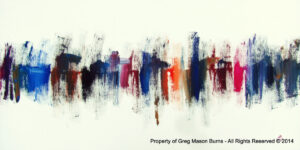
Trust in the process: This painting took time to realize
In the first part of this series, I mentioned two things. One is how the artist can never shut off the artistic process. And the other is that the artist is just as productive as the normal corporate worker, if not more so. In this part I’ll talk about the real reason why the starving artist exists.
The Myth of the Starving Artist
There is this myth that the starving artist exists because suffering creates great art. There may be some truth to this. It is generally considered to be true that Gabriel García Márquez used the last of his savings to send his final copy of 100 Years of Solitude to the publisher who helped bring him the fame that won him the Nobel Prize. There may be a connection between Márquez’s poverty and brilliance because his poverty required him to produce results. Maybe poverty really does produce greatness at times, but I think on average this is just a myth.
It wasn’t Márquez’s poverty that created greatness, but a societal misunderstanding of how an artist works that created his poverty. His genius was inside him the whole time. To suggest otherwise is both an insult to him and gives way to much credit to those who never rise out of poverty.

Trust in the process: Weeks of frustration led to this spontaneous painting
How Different are We?
The mind of an artist is a little different from the mind of an accountant, let’s say. The accountant is much more logical whereas the artist is much more emotional. In the logical world there are structures, or boundaries where the logical person must work within. Ideas are created with these specific structures in mind. “Going outside the box” simply means expanding the structure as it’s currently known. Being physically outside the box doesn’t help unless one is contemplating blowing up the whole structure. In the emotional world the person is the structure, and the world is built and destroyed on a whim.
Trust

Trust in the process: Months of thinking led to this combination of colors
Thinking is Crucial to Making Art
In short, it’s understanding that an artist needs to think before producing that requires trust, and that thinking is what makes the artist who he or she is. Without this understanding and trust, one will never be able to tolerate how the artistic process works, let alone allow it to progress as it needs to. Give me three or four months to produce several paintings and I will. Give me a day and I’ll also produce the same amount, but they likely won’t be as inspired as the ones that took longer, and with my art in particular this emotional aspect is necessary.
In the end, society needs to answer this question: do you want high-quality inspired works of art or do you want structured, dictated pieces of art? I’ve already suggested that art can help you make better decisions. It also works hand-in-hand with how science, and art provides value with regards to our health.
We should be finding a way to give the artist a chance to create the three-to-four month painting because this matters in real and concrete ways. Let the emotion simmer and understand that not all stoves boil at the same rate. When you do, don’t be afraid to suggest and convince people that we would be healthier if we supported this method of producing. (And by this I mean be willing to accept a society that pays for this thinking period as opposed to just firm results. After all, the accountant gets paid to think up the report before it’s finished.)
Comments: 2
While emotion has it’s influence certainly. I’d suggest intuition might be even more important or maybe a better word to describe the process.
My currently favorite quote from Einstein, “The intuitive mind is a sacred gift the rational mind a faithful servant. We have created a society the honors the servant and has forgotten the gift.”
Doesn’t that say it all?
Hi David,
I think intuition does play a large part in the creative process, but in my opinion it’s emotion that drives the actual creations. Intuition is a database of sorts of our experience through time. We need to build it in order to use it. Emotion, on the other hand, is within us – it tells us what we feel.
Intuition tells us what to do, while emotion tells us how we feel about it.
Sorry, the comment form is closed at this time.